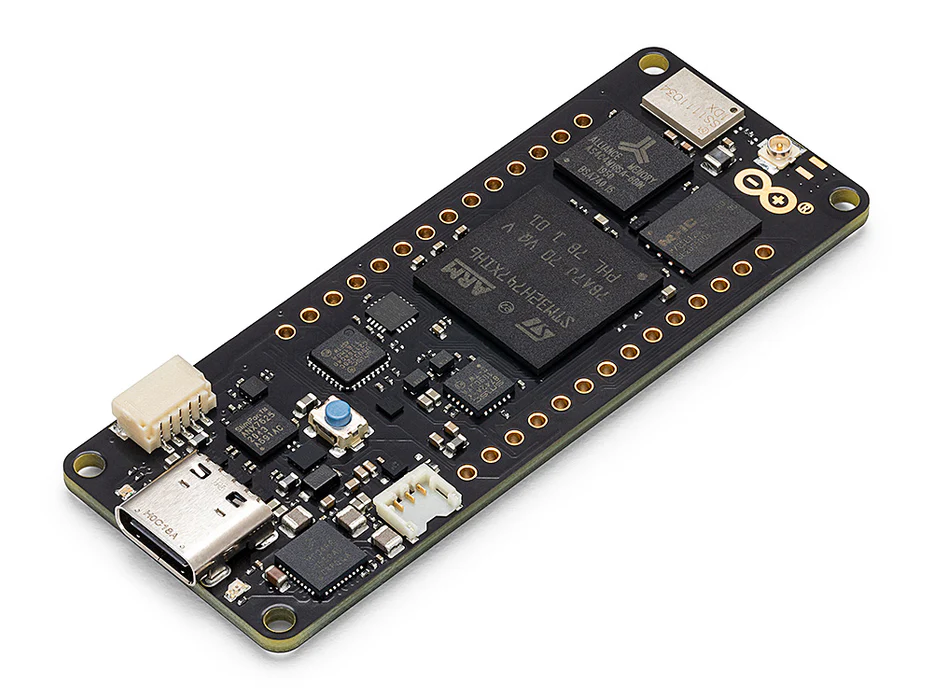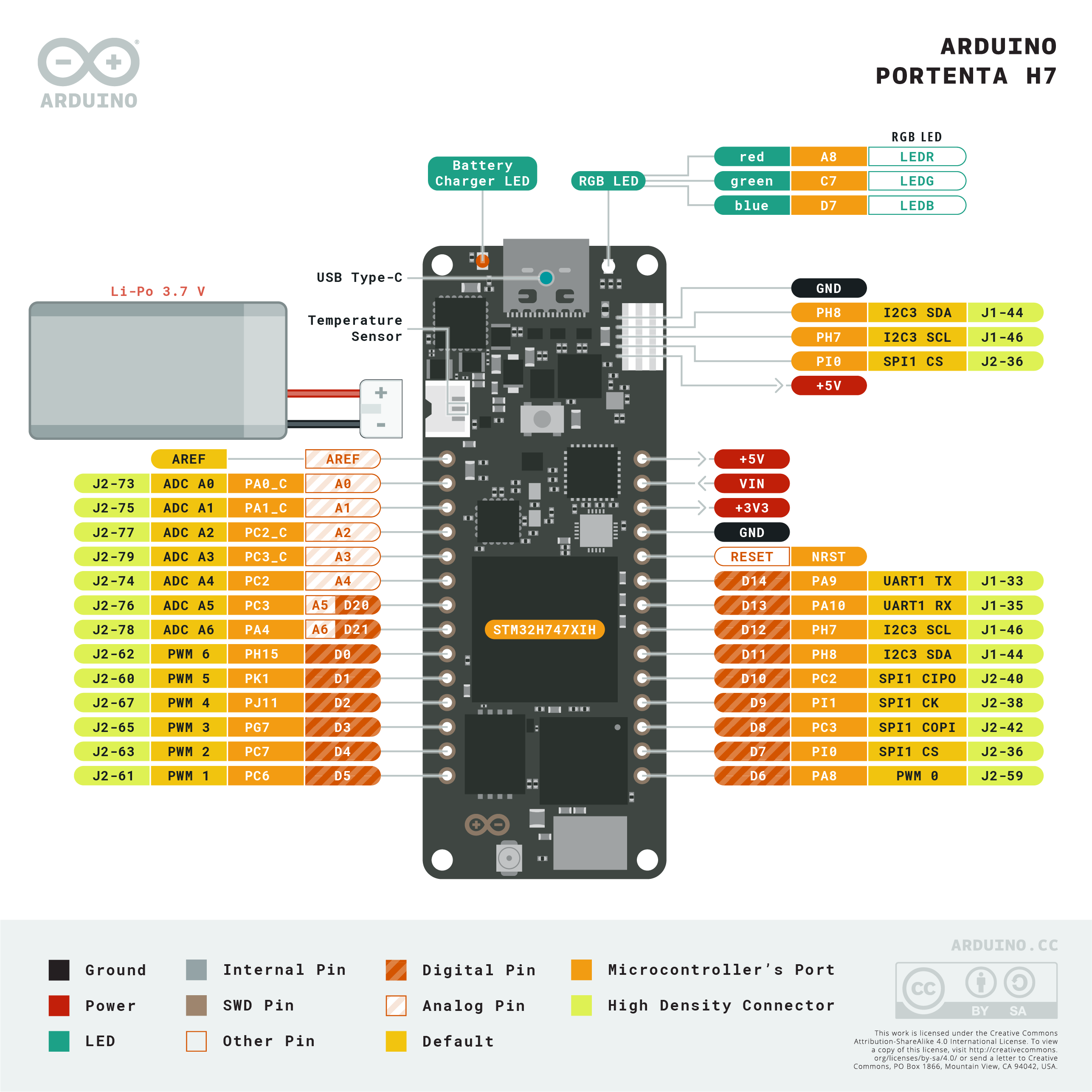
Overview
Portenta H7 allows you to build your next smart project. Ever wanted an automated house? Or a smart garden? Well, now it’s easy with the Arduino IoT Cloud compatible boards. It means: you can connect devices, visualize data, control and share your projects from anywhere in the world. Whether you’re a beginner or a pro, we have a wide range of plans to make sure you get the features you need.
Portenta H7 simultaneously runs high level code along with real time tasks. The design includes two processors that can run tasks in parallel. For example, is possible to execute Arduino compiled code along with MicroPython one, and have both cores to communicate with one another. The Portenta functionality is two-fold, it can either be running like any other embedded microcontroller board, or as the main processor of an embedded computer.
Portenta can easily run processes created with TensorFlow™ Lite, you could have one of the cores computing a computer vision algorithm on the fly, while the other could be making low-level operations like controlling a motor, or acting as a user interface.
Use Portenta when performance is key, among other cases, we envision it to be part of:
- High-end industrial machinery
- Laboratory equipment
- Computer vision
- PLCs
- Industry-ready user interfaces
- Robotics controller
- Mission-critical devices
- Dedicated stationary computer
- High-speed booting computation (ms)
Two Parallel Cores
H7's main processor is the dual core STM32H747 including a Cortex® M7 running at 480 MHz and a Cortex® M4 running at 240 MHz. The two cores communicate via a Remote Procedure Call mechanism that allows calling functions on the other processor seamlessly. Both processors share all the in-chip peripherals and can run:
- Arduino sketches on top of the Arm® Mbed™ OS
- Native Mbed™ applications
- MicroPython / JavaScript via an interpreter
- TensorFlow™ Lite
Graphics Accelerator
Probably one of the most exciting features of the Portenta H7 is the possibility of connecting an external monitor to build your own dedicated embedded computer with a user interface. This is possible thanks to the STM32H747 processor's on-chip GPU, the Chrom-ART Accelerator™. Besides the GPU, the chip includes a dedicated JPEG encoder and decoder.
A new standard for pinouts
The Portenta family adds two 80 pin high density connectors at the bottom of the board. This ensures scalability for a wide range of applications by simply upgrading your Portenta board to the one suiting your needs.
On-board Connectivity
The onboard wireless module allows to simultaneously manage WiFi and Bluetooth® connectivity. The WiFi interface can be operated as an Access Point, as a Station or as a dual mode simultaneous AP/STA and can handle up to 65 Mbps transfer rate. Bluetooth® interface supports Bluetooth Classic and Bluetooth® Low Energy. It is also possible to expose a series of different wired interfaces like UART, SPI, or I2C, both through some of the MKR styled connectors, or through the new Arduino industrial 80 pin connector pair. The 80-pin connector pair provides additional features including Ethernet.
USB-C® Multipurpose Connector
The board's programming connector is a USB-C port that can also be used to power the board, as a USB Hub, to connect a DisplayPort monitor, or to deliver power to OTG connected devices.
Multiple options in one board
Order the default Arduino Portenta H7 (codename H7-15EUNWAD) that comes with:
- STM32H747 dual-core processor with graphics engine
- 8MB SDRAM
- 16MB NOR Flash
- 10/100 Ethernet Phy
- USB HS
- NXP SE050C2 Crypto
- WiFi/BT Module
- External Antenna
- DisplayPort over USB-C
When it comes to high volume orders, we can customize the Portenta H7 configuration. Do you need additional memory? We got you covered: Contact us.
Arduino IoT Cloud Compatible
Use your MKR board on Arduino's IoT Cloud, a simple and fast way to ensure secure communication for all of your connected Things.
TRY THE ARDUINO IOT CLOUD FOR FREE
Need Help?
Check the Arduino Forum for questions about the Arduino Language, or how to make your own Projects with Arduino. Need any help with your board please get in touch with the official Arduino User Support as explained in our Contact Us page.
Warranty
You can find here your board warranty information.
Tech specs
The Arduino Portenta H7 is based on the STM32H747 microcontroller, XI series.
| Microcontroller | STM32H747XI dual Cortex®-M7+M4 32bit low power Arm® MCU (datasheet) |
| Radio module | Murata 1DX dual WiFi 802.11b/g/n 65 Mbps and Bluetooth® (Bluetooth® Low Energy. 5 via Cordio stack, Bluetooth® Low Energy 4.2 via Arduino Stack) (datasheet) |
| Secure Element (default) | NXP SE0502 (datasheet) |
| Board Power Supply (USB/VIN) | 5V |
| Supported Battery | Li-Po Single Cell, 3.7V, 700mAh Minimum (integrated charger) |
| Circuit Operating Voltage | 3.3V |
| Display Connector | MIPI DSI host & MIPI D-PHY to interface with low-pin count large display |
| GPU | Chrom-ART graphical hardware Accelerator™ |
| Timers | 22x timers and watchdogs |
| UART | 4x ports (2 with flow control) |
| Ethernet PHY | 10 / 100 Mbps (through expansion port only) |
| SD Card | Interface for SD Card connector (through expansion port only) |
| Operational Temperature | -40 °C to +85 °C |
| MKR Headers | Use any of the existing industrial MKR shields on it |
| High-density Connectors | Two 80 pin connectors will expose all of the board's peripherals to other devices |
| Camera Interface | 8-bit, up to 80 MHz |
| ADC | 3× ADCs with 16-bit max. resolution (up to 36 channels, up to 3.6 MSPS) |
| DAC | 2× 12-bit DAC (1 MHz) available, only one is accessible by the user through the external A6 pin |
| USB-C | Host / Device, DisplayPort out, High / Full Speed, Power delivery |
Conformities
Resources for Safety and Products
Manufacturer Information
The production information includes the address and related details of the product manufacturer.
Arduino S.r.l.
Via Andrea Appiani, 25
Monza, MB, IT, 20900
https://www.arduino.cc/
Responsible Person in the EU
An EU-based economic operator who ensures the product's compliance with the required regulations.
Arduino S.r.l.
Via Andrea Appiani, 25
Monza, MB, IT, 20900
Phone: +39 0113157477
Email: support@arduino.cc
Documentation
Study how the Portenta H7 board works using the following files:
SCHEMATICS IN .PDF DATASHEET IN .PDF
Pinout Diagram
The Portenta H7 follows the Arduino MKR form factor, but enhanced with the Portenta family 80 pin high-density connector. Learn more about the board's pinout by reading the board's pinout documentation.

Download the full pinout diagram as PDF here.
Learn more
Get Inspired

Button Clash is an exciting two-player game where the person who pushes their button faster wins! Built it with the Arduino Plug and Make kit.

The Arduino Plug and Make Kit was designed to open up infinite possibilities, breaking down the idea that technology is a “black box” reserved for experts. With its snap-together system, this kit gives everyone – beginners and seasoned makers alike – the power to create and innovate without barriers. Forget being a passive user! With the Plug and Make Kit, technology is accessible and ready to bring your ideas to life. Meet Giulio Pilotto, Plug and Make Kit Star Giulio Pilotto is one of Arduino’s senior software engineers and works closely on Arduino Cloud projects. When we held a “Make Tank” workshop at our Turin office to showcase the potential of the Plug and Make Kit, he joined in with inspiration from a recent escape room experience. The result was Riddle Treasure, a puzzle-based game that allows you to recreate the excitement of an escape room anywhere you are. At this year’s Maker Faire, Pilotto had the opportunity to present Riddle Treasure at the Arduino booth. While he had showcased his own creations at previous Maker Faire editions, this time felt special: “The Maker Faire is always a wonderful high-energy event,” he says. “I was happy to represent the Arduino team as we focus more than ever on the community: all our products were presented in the light of what people can do with them.” Riddle Treasure To be honest, this is probably the most advanced project our in-house “Make Tank” came up with (so far!). After all, it has to be somewhat complicated to emulate intricate escape room puzzles! However, following Pilotto’s step-by-step instructions on Project Hub and leveraging the easy snap-together mechanism of Modulino nodes, anyone can recreate Riddle Treasure – or even invent a personal, unique variation. The goal of the game is to unlock a safe. But to get there, you need to complete three steps in order. 1. Combination Lock: First, you must rotate the encoder in Modulino Knob like a
FAQs
Special Configuration Request
The Portenta H7 is a highly configurable design, it is possible to order boards with different configurations of memory, crypto chip, antenna, etc. These request will be channelled through Arduino's sales team and will require a minimum amount order. We recommend you try the default H7 configuration and if you need specific features for your solution, then contact us to discuss the terms.
Batteries, Pins and board LEDs
- Battery capacity: Rechargeable Li-Ion, or Li-Po. Please make sure the battery connector suits your battery.
- Vin: This pin can be used to power the board with a regulated 5V source. If the power is fed through this pin, the USB power source is disconnected. This is the only way you can supply 5v (range is 5V to maximum 6V) to the board not using USB. This pin is an INPUT.
- 5V: This pin outputs 5V from the board when powered from the USB connector or from the VIN pin of the board. It is unregulated and the voltage is taken directly from the inputs.












